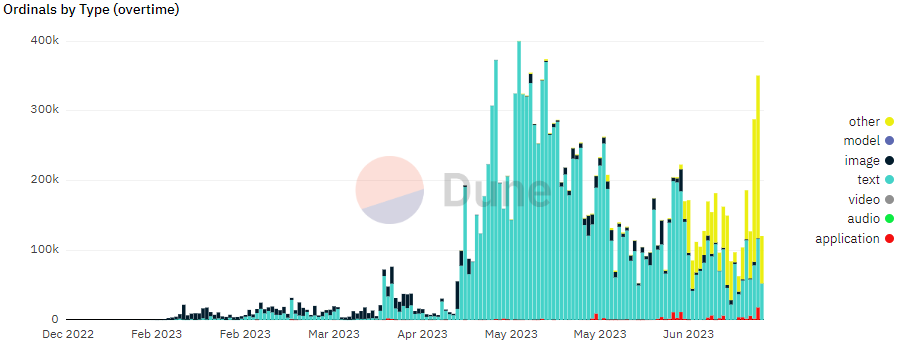Bitcoin Ordinals Inscriptions Expand With Developer Support

[ad_1]
Bitcoin Ordinals inscriptions have surged in volume since April. And as more users embrace the technology, they are inscribing more complex data formats.
Simple text-based inscriptions initially dominated Bitcoin Ordinals. But on Saturday, over 18,000 inscriptions were made by applications. And other inscription types are growing in popularity.
What are Bitcoin Ordinals Inscriptions?
Bitcoin Ordinals allow people to inscribe individual satoshis with additional data.
The technology has been lauded as a game-changer by the Bitcoin community because it allows people to record all kinds of data on the Bitcoin blockchain. Previously, using the Bitcoin ledger in such a manner was difficult. Unlike more modern, multifunctional blockchains, the network was pretty limited to recording financial transactions.
One of the primary draws of Bitcoin Ordinals is that they allow users to record different data formats on-chain, including video and image files. As a result, it is now possible to mint NFTs of Bitcoin. A host of other functions that weren’t previously possible have also been developed.
Since Ordinals were introduced in January 2023, nearly 16 million inscriptions have been made. These have caused the Bitcoin blockchain to explode in size.
Initially, Ordinals were largely used to make basic, text-based inscriptions. And at present, the 13 million odd text-based inscriptions account for over three-quarters of the total.
But alternative types of inscription are on the rise.
Application Inscriptions Surge
As one Dune analytics dashboard shows, non-text inscriptions have surged recently. Inscriptions of JSON files and those that fall into the “other” category are currently powering the trend for diversification.

A popular data format for web applications, the increased prevalence of JSON inscriptions points to app developers’ growing usage of Bitcoin Ordinals. And on Saturday, the number of Ordinals minted by applications reached a new high point of 18,115.
Ordinals have now inscribed over 140,000 JSON files on the Bitcoin ledger. That makes it the fifth-largest data type after text, “other,” PNG images, and WebP images.
The “other” category includes all data formats not otherwise tracked. Its growing volume further demonstrates the diversification of Ordinals inscriptions.
An Unintended Consequence
The core developers and miners who signed off on the network’s Taproot upgrade in November 2021 may never have envisaged the far-reaching consequences of their decision.
Thanks to that upgrade, Ordinals have captured the interest of the global Bitcoin community, who have run with the concept.
After all, at root, different digital data formats are based on computer code. Accordingly, the process for writing that data on-chain is fundamentally the same.
Of course, some will argue that Ordinals offer no major advantages over alternative solutions, such as Ethereum-based ones. But that hasn’t stopped developers from experimenting with new use cases for the technology.
Likewise, concerns that Ordinals inscriptions are clogging up the Bitcoin network and driving up transaction fees appear to have done little to slow their growth.
Disclaimer
In adherence to the Trust Project guidelines, BeInCrypto is committed to unbiased, transparent reporting. This news article aims to provide accurate, timely information. However, readers are advised to verify facts independently and consult with a professional before making any decisions based on this content.
[ad_2]
Source link

